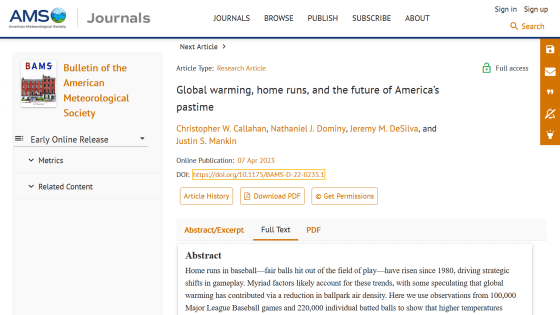``The number of MLB home runs is increasing due to global warming,'' researchers claim

by
A home run is the highlight of baseball, and the feeling of watching a high-flying batted ball disappear into the stands is exceptional not only for the batter who hit it, but also for the fans. A research team led by Christopher Callahan , who studies climate science at Dartmouth College in the United States, investigated the relationship between the number of home runs in Major League Baseball (MLB), the world's highest professional baseball league, and temperature. The number of MLB home runs is increasing due to global warming.'
Global warming, home runs, and the future of America's pastime in: Bulletin of the American Meteorological Society - Ahead of print
https://doi.org/10.1175/BAMS-D-22-0235.1

MLB home run counts are rising – and global warming is playing a role
https://theconversation.com/mlb-home-run-counts-are-rising-and-global-warming-is-playing-a-role-203226
Baseball home runs could increase by 10% in the next 80 years.
https://www.livescience.com/baseball-home-runs-could-increase-by-10-percent-in-the-next-80-years-heres-why
The MLB regular season consists of 30 teams based in the United States and Canada, and each team plays 162 games per year, for a total of about 5,000 games per year. In recent years, the number of home runs in MLB has increased, and the number of home runs per game has exceeded one.
The graph below shows the average number of home runs per game from 1963 to 2022. Overall, the percentage of home runs is on the rise, and since 2015 the number of home runs per game has consistently exceeded one. Except for 2020, when the number of games was small due to the influence of the new coronavirus infection (COVID-19), the annual number of home runs since 2016 has been more than 5,000.
The increase in the number of home runs in recent years has been attributed to
'Physics offers a simple and convincing theory: warm air is less dense than cold air. When air gets hot and its molecules move faster, it expands,' says Callahan and colleagues. 'There's more space between the molecules. As a result, a ball hit should fly farther on a warm day than on a cool day because there's less air resistance.'

However, although it has been shown that baseballs fly farther when warm, no scientific research has been done to show that temperature is actually related to home runs. Therefore, Callahan and colleagues conducted a study to analyze more than 100,000 MLB games from 1962 to 2019 and the day's weather data.
Of course, it is not possible to reproduce all at-bats since the 1960s and evaluate the effect of temperature alone on home runs. However, since temperature has little correlation with various factors related to home runs, such as ball design, players taking
In addition, by examining the launch angle and launch velocity of hit balls measured by high-speed cameras installed at MLB ballparks since 2015, we will investigate how the trajectory of a hit ball with the same launch angle and launch velocity changes depending on the temperature. It is also possible. “The high-speed camera model almost exactly reproduced the effect of temperature on home runs as estimated from the game-level data,” Callahan and colleagues said. Using model experiments, we were able to estimate how many home runs have occurred so far due to the effects of climate change.'
As a result of the analysis, it was found that the probability of hitting a home run was about 20% higher in a game played on a day when the temperature was 10 degrees Celsius higher than the average day. We also found that a total of more than 500 home runs that occurred from 2010 to 2019 may be related to a decrease in air density due to anthropogenic global warming.

by Minda Haas Kuhlmann
According to Callahan's analysis, if greenhouse gas emissions are not reduced as they are now, the impact of rising temperatures could increase the number of home runs by 192 per year by 2050 and 467 per year by 2100. ... apparently ...
In the graph below, the vertical axis shows the global average temperature (GMST) and the horizontal axis shows each MLB ballpark, mapping the relationship between temperature rise and the number of annual home runs. While the overall number of home runs increases as the temperature rises, it can be seen that the change in the number of home runs due to temperature rise is small at the dome stadium indicated by '·' where the internal temperature can be adjusted.
MLB teams could control the impact of rising temperatures on home run numbers by playing more nighttime games instead of daytime games, and by adding a dome over the stadium to regulate the internal temperature. It is possible.
“Rising temperatures threaten the health and safety of baseball players, stadium fans, and people around the world,” Callahan and others said. 'The rise will change almost every aspect of society, from cultural norms like baseball to basic human well-being.'
Related Posts:
in Science, Posted by log1h_ik







